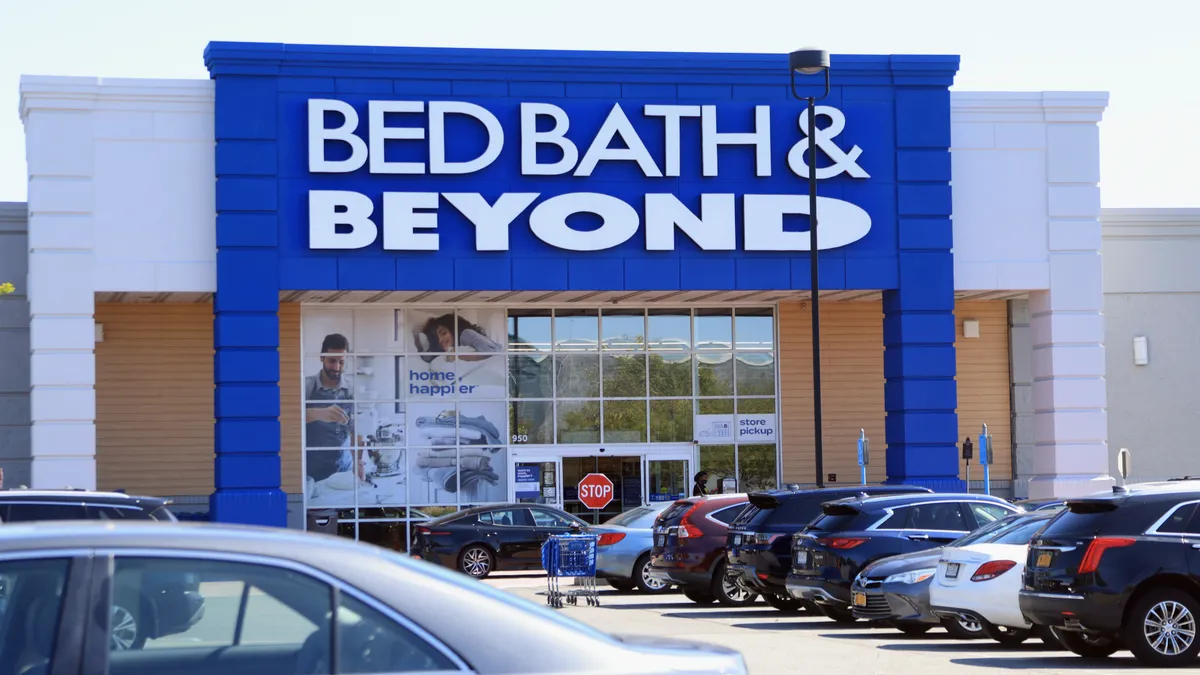Dive Brief:
- S&P Global Ratings on Monday upgraded Bed Bath & Beyond’s credit rating to CCC- from D after the distressed retailer recently made an interest payment that was due Feb. 1.
- The financial ratings and analytics firm also raised its ratings on its senior unsecured debt to C from D, analysts said in a release.
- Despite the ongoing turnaround efforts, S&P says it's maintaining a negative outlook, citing Bed Bath & Beyond’s unsustainable capital structure, “substantial debt burden, constrained liquidity, and the challenging prospects of turning around operating performance.”
Dive Insight:
After narrowly avoiding bankruptcy, Bed Bath & Beyond’s financial position remains precarious, S&P said. A CCC- rating from S&P indicates that a company is “currently vulnerable and dependent on favorable business, financial and economic conditions to meet financial commitments.”
“We believe [Bed Bath & Beyond’s] turn-around prospects remain very weak,” S&P analysts said Monday. “In our view, BBBY's customer value proposition has eroded significantly due to poor merchandising decisions, deficient omnichannel capabilities, and a lack of available inventory in key product categories.”
In a short statement published March 1, Bed Bath & Beyond confirmed it paid the interest due on its debt on Feb. 28. The company said the Bank of New York Mellon is the trustee of the senior notes. Bed Bath & Beyond did not immediately respond to a Tuesday request for further comment from Retail Dive about the S&P rating change or the status of the company’s turnaround plan.
About $225 million in last-minute funding raised last month through a stock offering saved Bed Bath & Beyond from almost certain bankruptcy. Along with $800 million in stock-related proceeds over time, and by drawing $100 million from a first-in-last-out loan, the company wants to raise about $1 billion.
The home goods retailer faces new signs of trouble as it attempts to turn itself around. Bloomberg reported last week that the equity financing keeping Bed Bath & Beyond solvent is at risk because of the company’s falling stock price. Future infusions of cash are contingent on maintaining an average stock price of $1.25 to $1.50. But its stock price closed at $1.41 on Feb. 28. Bloomberg reports that the terms of the deal allow financier Hudson Bay Capital to waive that condition at its discretion.
The company reported third-quarter net sales fell 33% year over year to $1.3 billion and comp sales declined 32%. S&P projects that the retailer’s Q4 comp store sales likely fell sharply “and that these trends have continued into the current fiscal year.”
S&P also said Bed Bath & Beyond does not have a strong track record of successfully implementing strategic initiatives. As a result, “we believe reversing years of market share losses amid a highly competitive environment featuring better-capitalized and equipped competitors will be very difficult.” To turn itself around, S&P said Bed Bath & Beyond needs to improve its merchandise offering. And to do that, the retailer must mend its relationships with vendors.
Those relationships “have been frayed due to delayed payments,” S&P said. The company’s need to rebuild its inventory, along with tighter payment terms from concerned vendors likely “will continue to strain working capital and cash flow generation.” On top of that, S&P noted that consumer spending on home goods remains constrained due to inflation-related pressures.
S&P warned Bed Bath & Beyond’s rating could slip again if it announces or engages in an exchange offer or debt restructure or again is unable to meet its debt payment obligations. The rating could also increase if the retailer effectively implements its turnaround strategy.
As part of its turnaround efforts, Bed Bath & Beyond is working to shrink its store footprint significantly. In January, the retailer moved to shut down all of its Harmon beauty stores.













